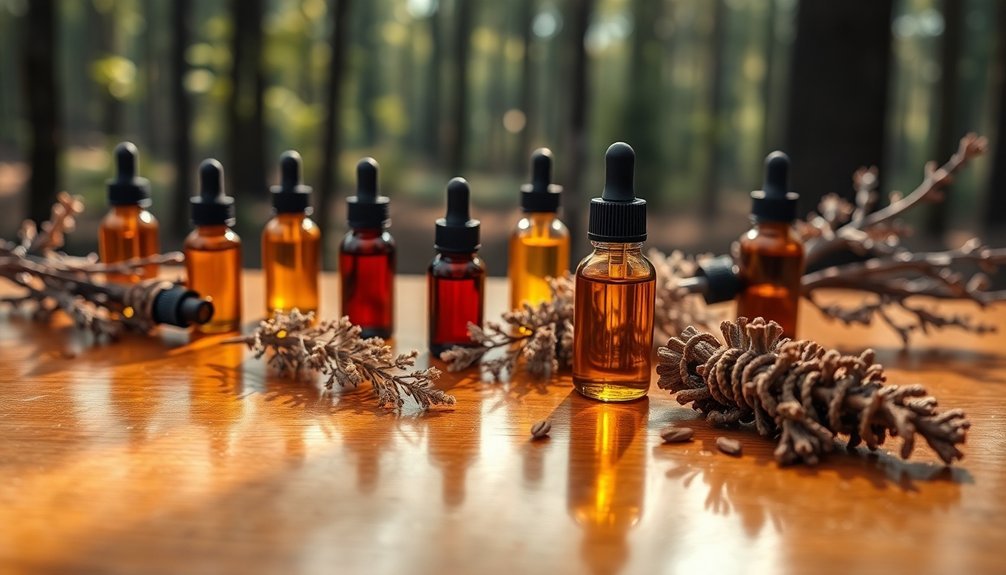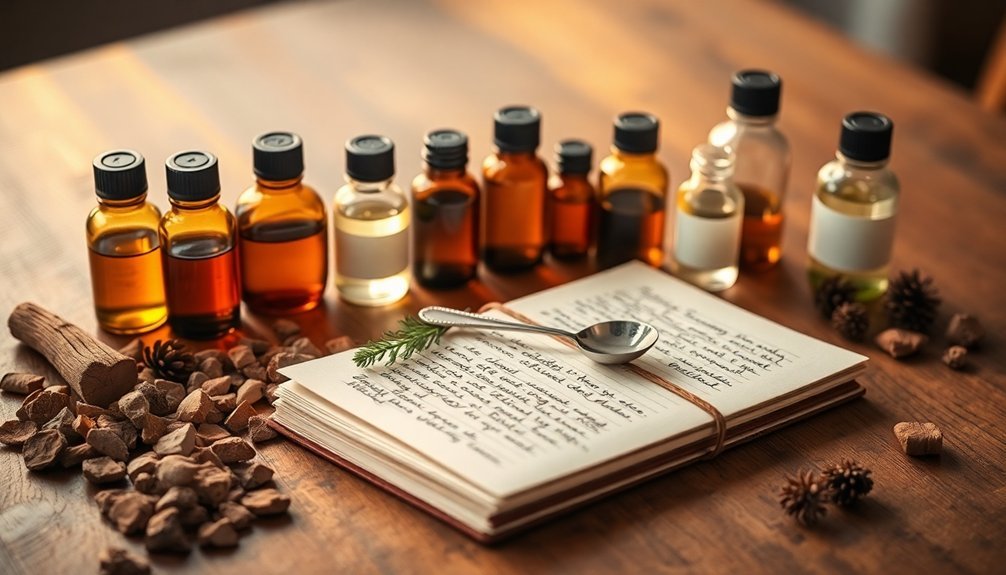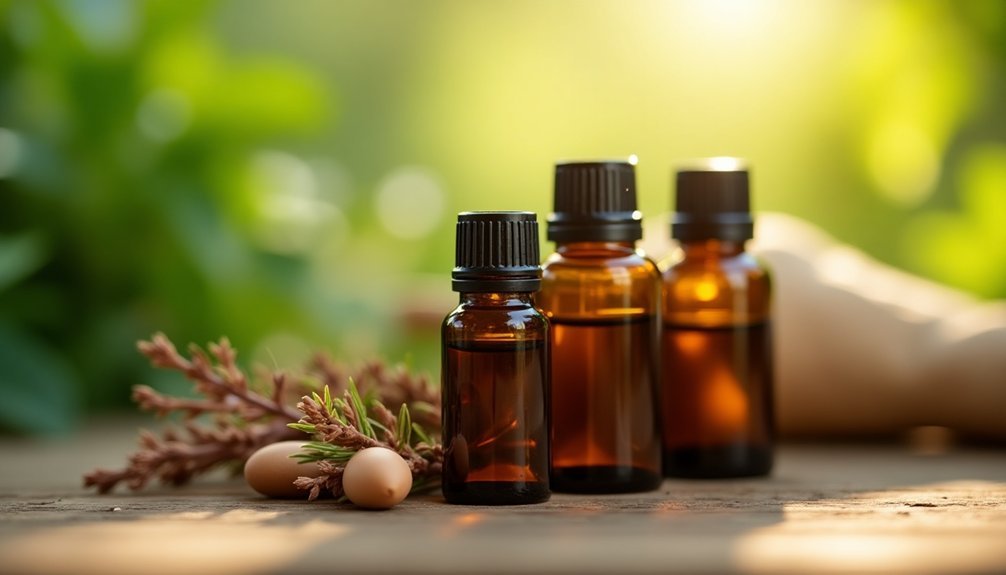To create perfect woody fragrances, you'll need to master five key techniques. Start with quality essential woods like sandalwood and cedarwood, then pair them strategically with complementary notes such as citrus or florals. Follow the classic 30:50:20 ratio for blending, and enhance your creation with oriental elements like amber or spices. Apply your fragrance to moisturized skin and pulse points for longevity. These professional secrets will reveal your path to crafting sophisticated, lasting scents.
Understanding Essential Woods: From Sandalwood to Oak

The world of woody fragrances reveals itself through an array of precious essential woods, each carrying its own distinctive character and cultural significance.
You'll find sandalwood's sweet, milky notes dominating India's fragrance landscape, where it's not just a scent but a spiritual essence used in religious ceremonies. 90% of oil production comes from Indian sandalwood trees.
When you're exploring woody fragrances, you'll encounter cedarwood's sharp, earthy character from the Mediterranean and Himalayas, often used to ground perfume compositions.
The legendary agarwood (oud) stands out as "liquid gold," offering complex notes that range from vanilla to bitter undertones.
From the Amazon comes rosewood, adding sophisticated floral and spicy dimensions to fragrances.
Understanding these essential woods isn't just about recognizing their scents—it's about appreciating their unique origins, sustainable harvesting practices, and the artistry behind their extraction.
The Art of Pairing Woody Notes With Complementary Scents
When crafting the perfect woody fragrance, mastering the art of scent pairing can transform a simple perfume into an extraordinary olfactory experience.
You'll find four main pairing strategies that consistently deliver remarkable results.
First, pair woody notes within the same fragrance family to create depth and harmony. Try combining different wood subfamilies like mossy and dry woods. A prime example is the combination of Portobello Oud & Amber for an intensely cozy effect.
For a fresh, energizing twist, blend woody bases with citrus notes – perfect for daytime wear.
If you're seeking elegance, mix woody notes with florals or fruits to achieve a sophisticated profile.
For evening events, combine woody notes with oriental notes like amber and spices to create a luxurious, sensual atmosphere.
Mastering the Perfect Woody Blend Ratios

Creating perfect woody blend ratios demands a thorough understanding of fragrance composition fundamentals.
Because individual preferences vary, consider your personal response to each woody note when determining your ideal ratio.
You'll want to start with the classic 30:50:20 ratio – that's 3 drops of top notes, 5 drops of middle notes, and 2 drops of base notes.
When working with woody scents, you'll need to adjust these ratios based on the intensity of each oil. Strong base notes like cedarwood might require less than the standard 20% to avoid overwhelming your blend.
Begin with a total of 10 drops, then test and adjust. Let your blend rest for at least 24 hours to allow the scents to harmonize fully.
Secret Techniques for Balancing Wood-Based Fragrances
Mastering secret techniques for balancing wood-based fragrances starts with understanding how different fragrance families interact with woody notes.
You'll find that citrus notes like bergamot and lemon add a vibrant lift while extending the longevity of your blend. For sophistication, pair woods with florals like jasmine or rose to create depth and elegance.
To enhance your woody base, consider adding vanilla or tonka bean for a creamy, sensual touch. If you're aiming for mystery, incorporate oriental elements like spices and amber.
For year-round versatility, try combining woods with fougère notes, especially lavender, which creates an invigorating freshness. When you want to add luxury, leather accords work beautifully with woods, creating a rich, sophisticated signature that's perfect for formal occasions.
Crafting Long-Lasting Woody Perfumes That Evolve

To craft woody perfumes that truly last, you'll need to focus on strategic layering and note selection. Choose deep base notes like oud, cashmere wood, and amber, then blend them with complementary heart notes from floral or ambery families to create complexity and staying power.
Apply your woody fragrance strategically by moisturizing first – this creates the perfect canvas for long-lasting scent retention. Target pulse points where skin is warmest, and consider a light application on clothes or hair to trap the fragrance compounds effectively.
For maximum evolution and longevity, opt for concentrated formulations like Eau de Parfum. Remember that environmental factors matter too – cooler temperatures will help your woody scent last longer.
Don't rub the fragrance when applying; instead, gently dab it to preserve the perfume's intended progression.
Frequently Asked Questions
Can Woody Fragrances Be Used in Reed Diffusers and Candle Making?
Yes, you can use woody fragrances in both reed diffusers and candles. You'll need to follow IFRA guidelines for proper concentration levels and make certain they're compatible with your chosen base materials for best results.
How Do Seasonal Changes Affect the Performance of Woody Perfumes?
You'll notice your woody perfumes perform differently across seasons. They're stronger in summer's heat and humidity, more subtle in winter's cold, and work best during autumn when crisp air perfectly balances their rich notes.
Are Synthetic Woody Notes More Sustainable Than Natural Alternatives?
While you'll find synthetic woody notes reduce strain on endangered species and offer consistent production, they can cause pollution. Natural alternatives are biodegradable but require extensive resources and long cultivation periods.
Do Woody Fragrances Interact Differently With Different Skin Types?
Yes, your skin type considerably affects how woody fragrances perform. You'll notice they're stronger on oily and alkaline skin, more balanced on normal skin, and tend to fade faster on acidic skin.
Can Woody Fragrances Cause Allergic Reactions in Sensitive Individuals?
Yes, you can experience allergic reactions to woody fragrances if you're sensitive. Common symptoms include sneezing, itchy eyes, and skin reactions. Watch for signs like rashes or breathing issues when trying new scents.
In Summary
You've now mastered the fundamentals of blending woody fragrances like a pro. With your knowledge of essential woods, complementary pairings, and precise ratios, you're ready to create sophisticated scents that tell your unique story. Don't forget to test your blends thoroughly and allow them time to mature. Trust your nose, stay patient with the process, and you'll craft wood-based perfumes that stand the test of time.





Leave a Reply